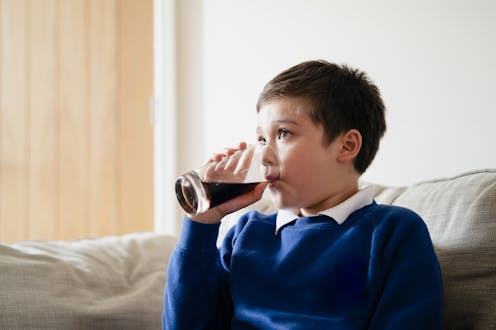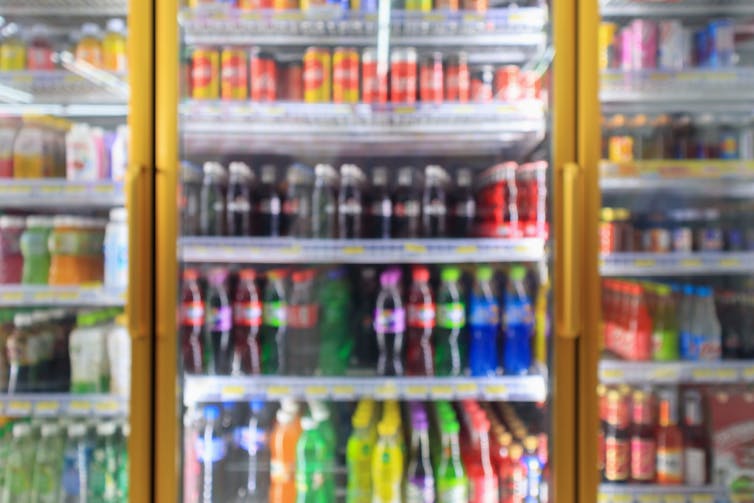
The introduction of the UK’s soft drinks industry levy, commonly known as the sugary drinks tax, was associated with reduced obesity among 10- and 11-year-old girls, according to a recent study.
So does this suggest the sugary drinks tax is working? And why wasn’t this effect seen in boys? Let’s take a look.
The UK’s sugary drinks tax was announced in March 2016 and introduced in April 2018. It applies to soft drinks with added sugar and has a two-tier structure.
Soft drinks containing between 5 grams and 8 grams of sugar per 100ml are taxed £0.18 per litre, and those with more than 8 grams of sugar per 100ml are taxed £0.24 per litre. No tax applies to soft drinks with less than 5 grams of sugar per 100ml.
The structure of this levy differs from most other countries, where soft drinks are levied by volume of product sold. Taxing drinks depending on how much sugar they contain incentivises manufacturers to reformulate products.
Tiered taxes such as the UK’s provide even stronger incentives for reformulation because, particularly for those products closer to the thresholds, small reductions in sugar content could mean moving to a lower tier and so paying significantly less tax.
Read more: Sugary drinks tax is working – now it's time to target cakes, biscuits and snacks
What does the study find?
The researchers used population health data from the National Child Measurement Programme, which measures the height and weight of children in reception (ages four to five) and year 6 (ages 10 to 11), to assess how many children were overweight and obese in British primary schools.
This programme also collects information on the socioeconomic status of the area each child’s primary school fits into. Areas are classified into one of five levels based on how they fare in domains such as income, health, employment and education. This is called the index of multiple deprivation.
The results showed the introduction of the sugary drinks tax was associated with an 8% lower incidence of obesity in year 6 girls compared with the expected rate if the tax hadn’t been introduced. The authors estimated this 8% relative reduction would be equivalent to 5,234 averted cases of obesity in year 6 girls annually.

The reductions were greatest among girls who attended schools in the most deprived areas.
There were no significant reductions in the prevalence of obesity among year 6 boys, nor among children in reception. This could be because older children generally drink more soft drinks than younger children.
But why girls and not boys? This is a difficult question to answer, though there a host of possible reasons. For example, it might be that girls have been more exposed to public health messaging around the sugary drinks tax, or perhaps that boys have had greater exposure to the advertising of energy-dense foods and drinks touted to boost physical performance.
Some limitations
Most studies conclude that sugary drinks taxes reduce consumption of high-sugar soft drinks, and have positive effects on health, such as reducing diabetes and obesity. But this study is the first to investigate the association between the UK’s sugary drinks tax and obesity prevalence in children.
There are a few limitations, some of which the authors acknowledge. First, this is an observational study that has looked at existing available data. The researchers haven’t followed the same children over time or been able to compare children who have and haven’t been subject to the tax at the same time, so it’s not possible to ascertain a direct causal relationship. That means there may be other factors which could explain the changed obesity levels.

There might have been other local policies accompanying the sugary drinks tax such as promotion of physical activity, or informational campaigns, that may have affected children in different ways. The sugary drinks tax was followed by advertising restrictions on unhealthy products, particularly for children.
The researchers also estimated how deprived children were based on where they lived, not on their household circumstances. This means they haven’t been able to rule out whether deprivation is what’s behind the different obesity rates.
Read more: Banning the promotion of soft drinks could be more effective than a sugar tax
We do know that many manufacturers changed their products after the sugary drinks tax was introduced. A study published in 2020 found that after the tax was implemented, there was a sharp increase in the proportion of soft drinks with sugar levels just below 5 grams per 100ml. This suggests many manufacturers reformulated their drinks to come in just below the lower tier threshold.
But it’s unlikely that this alone could explain changes in obesity, particularly in children. Even when implemented as two-tiered levies, sugar taxes should be accompanied by a wider set of measures that recognise the multidimensional factors impacting obesity.
This broader approach should include support for information campaigns, nutrition labelling, and built environments conducive to physical activity such as green spaces and less car-dependent neighbourhoods.
Eleonora Fichera works at the Department of Economics, University of Bath. This is the same institution as one of the authors (Harry Rutter), but a different department. Eleonora Fichera has never co-authored any article with Harry Rutter.
This article was originally published on The Conversation. Read the original article.







